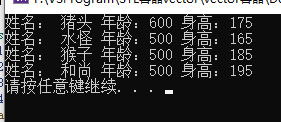- 赋值、构造、大小、为空、删除 、添加
- 移除 remove( 10 ) 删除容器中所有与10 匹配的元素
- 双向循环链表
- 迭代器是不支持随机访问的
- 反转排序
- reverse 反转
- 排序 成员函数 sort
- 默认排序 从小到大
- 自定义数据类型,必须指定排序规则
- 高级 多排序规则
#define _CRT_SECURE_NO_WARNINGS #include <iostream> using namespace std; #include <list> /* list构造函数 list<T> lstT;//list采用采用模板类实现,对象的默认构造形式: list(beg,end);//构造函数将[beg, end)区间中的元素拷贝给本身。 list(n,elem);//构造函数将n个elem拷贝给本身。 list(const list &lst);//拷贝构造函数。 list数据元素插入和删除操作 push_back(elem);//在容器尾部加入一个元素 pop_back();//删除容器中最后一个元素 push_front(elem);//在容器开头插入一个元素 pop_front();//从容器开头移除第一个元素 insert(pos,elem);//在pos位置插elem元素的拷贝,返回新数据的位置。 insert(pos,n,elem);//在pos位置插入n个elem数据,无返回值。 insert(pos,beg,end);//在pos位置插入[beg,end)区间的数据,无返回值。 clear();//移除容器的所有数据 erase(beg,end);//删除[beg,end)区间的数据,返回下一个数据的位置。 erase(pos);//删除pos位置的数据,返回下一个数据的位置。 remove(elem);//删除容器中所有与elem值匹配的元素。 list大小操作 size();//返回容器中元素的个数 empty();//判断容器是否为空 resize(num);//重新指定容器的长度为num, 若容器变长,则以默认值填充新位置。 如果容器变短,则末尾超出容器长度的元素被删除。 resize(num, elem);//重新指定容器的长度为num, 若容器变长,则以elem值填充新位置。 如果容器变短,则末尾超出容器长度的元素被删除。 list赋值操作 assign(beg, end);//将[beg, end)区间中的数据拷贝赋值给本身。 assign(n, elem);//将n个elem拷贝赋值给本身。 list& operator=(const list &lst);//重载等号操作符 swap(lst);//将lst与本身的元素互换。 list数据的存取 front();//返回第一个元素。 back();//返回最后一个元素。 list反转排序 reverse();//反转链表,比如lst包含1,3,5元素,运行此方法后,lst就包含5,3,1元素。 sort(); //list排序 */ void printList(list<int>& L) { for (list<int>::iterator it = L.begin(); it != L.end(); it++) { cout << *it << " "; } cout << endl; } //构造 void test01() { list<int> L(10, 10); list<int> L2(L.begin(), L.end()); //区间方式构造 printList(L); printList(L2); } //插入和删除数据 void test02() { //插入 list<int>L; L.push_back(10); //尾插 L.push_back(20); L.push_back(30); L.push_front(200); //头插 L.push_front(300); L.push_front(100); printList(L); //100, 300, 200,10,20,30 //删除 L.pop_back(); //尾删 L.pop_front(); //头删 printList(L); //300 200 10 20 //指定迭代器位置插入 //L.insert(L.begin() + 1, 1000); //error list不支持随机访问 L.insert(L.begin(), 1000); printList(L); //1000 300 200 10 20 //删除list中所有指定的元素 L.push_back(10); L.remove(10); //参数 直接放想删的数值 printList(L); //1000 300 200 20 } //大小尺寸、赋值、存取 void test03() { //大小尺寸操作 list<int>L; L.push_back(10); //尾插 L.push_back(20); L.push_back(30); L.push_front(200); //头插 L.push_front(300); L.push_front(100); cout << "大小" << L.size() << endl; if (L.empty()) { cout << "L为空" << endl; } else { cout << "L不为空" << endl; } L.resize(10); printList(L); //100 300 200 10 20 30 0 0 0 0 L.resize(3); //100 300 200 //赋值操作 list<int>L2; L2.assign(L.begin(), L.end()); //存取 cout << "front:" << L2.front() << endl; //获取头元素 100 cout << "back:" << L2.back() << endl; //获取尾元素 200 } //反转排序 #include <algorithm> //排序需要系统算法 bool myCompare(int v1, int v2) { return v1 > v2; //降序 } void test04() { list<int>L; L.push_back(10); L.push_back(20); L.push_back(40); L.push_back(30); L.reverse(); printList(L); //30 40 20 10 //所有不支持随机访问的迭代器,不可以用系统提供的算法 //sort(L.begin(), L.end()); //error //如果不支持用系统提供的算法 那么这个类内部会提供 L.sort(); //默认从小到大 printList(L); //10 20 30 40 L.sort(myCompare); //把回调函数名放入 printList(L); //40 30 20 10 } //自定义数据类型 class Person { public: Person(string name, int age, int height) { this->m_Name = name; this->m_Age = age; this->m_Height = height; } string m_Name; int m_Age; int m_Height; }; //自定义数据类型 排序必须指定规则 bool personCompare(Person p1, Person p2) { if (p1.m_Age == p2.m_Age) { return p1.m_Height < p2.m_Height; //身高升序 } else { return p1.m_Age > p2.m_Age; //年龄降序 } } void printPerson(list<Person> &L) { for (list<Person>::iterator it = L.begin(); it != L.end(); it++) { cout << "姓名: " << (*it).m_Name << " 年龄:" << (*it).m_Age << " 身高:" << (*it).m_Height << endl; } } void test05() { list<Person> L; Person p1("猴子", 500, 185); Person p2("猪头", 600, 175); Person p3("水怪", 500, 165); Person p4("和尚", 500, 195); L.push_back(p1); L.push_back(p2); L.push_back(p3); L.push_back(p4); //printPerson(L); L.sort(personCompare); printPerson(L); } int main() { test05(); //test04(); //test03(); //test02(); //test01(); system("Pause"); return 0; }
自定义排序结果:



